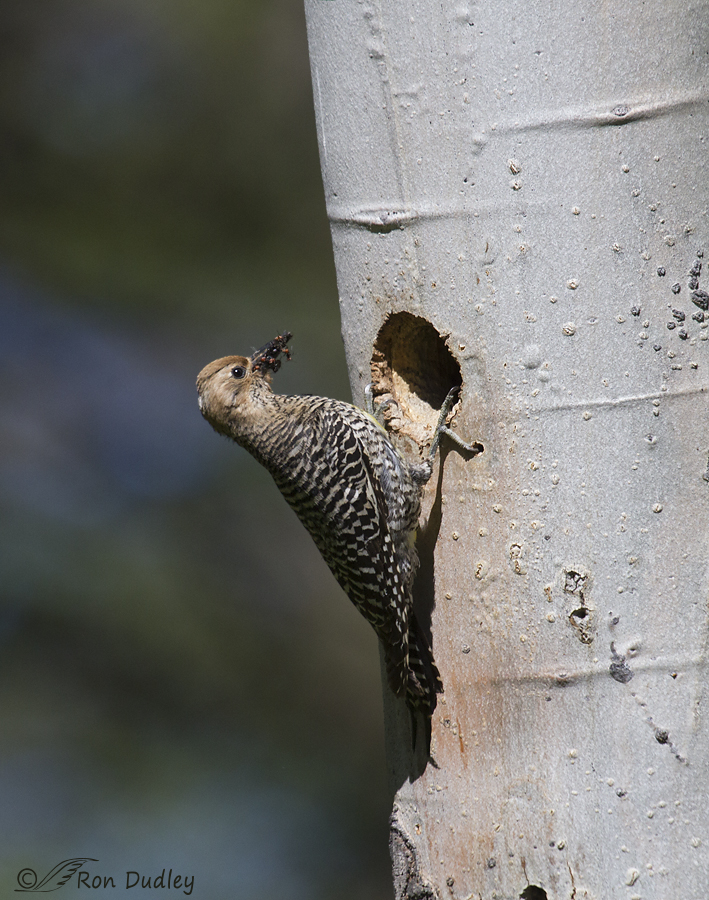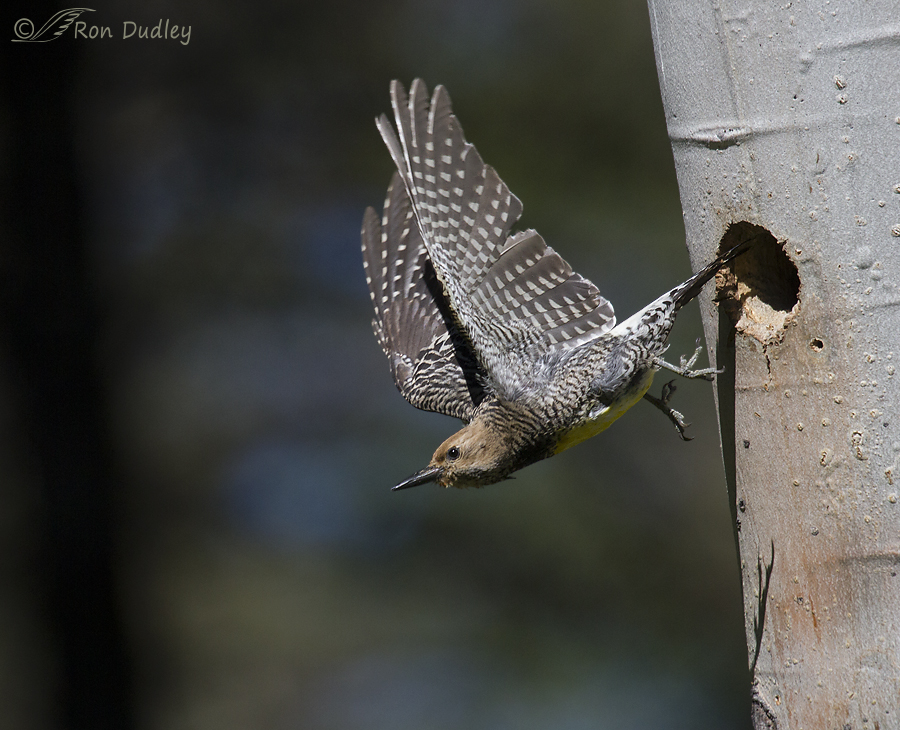I worked all day yesterday (with time out for a much-needed and lengthy nap) culling thousands of images from the Montana/Idaho trip but as the day ended and the dreaded fireworks began I still had 1449 photos left to sift through so this will be another relatively short post. I should be able to complete the much-loathed culling chore sometime this morning.

1/3200, f/5.6, ISO 640, Canon 7D, Canon EF100-400mm f/4.5-5.6L IS USM @ 370mm, not baited, set up or called in
Since my previous post featured the highly colorful male I decided to focus on the more subtly hued female this morning. Here she’s delivering ants to her hungry chicks in the nest-hole. For much of the year Williamson’s Sapsuckers feed exclusively on conifer phloem and sap but they shift mainly to ants when the young hatch. This species depends more heavily on ants than any other North American woodpecker.
It was fascinating to see how many ants an adult could hold in its beak. It appears to me that each one is grasped by one or more of its legs with the body hanging outside the bill (perhaps to partially protect from bites from any that may still be alive?). In certain light the insects caused the beak to appear strangely shaped but in this image I think what’s going on is clear.

1/4000, f/5.6, ISO 640, Canon 7D, Canon EF100-400mm f/4.5-5.6L IS USM @ 370mm, not baited, set up or called in
Here she’s leaving the nest after delivering the ants in the previous image.
Williamson’s Sapsuckers are unique among woodpeckers for having spectacular sexual differences in plumage color. As you may have seen in my previous post the male is black, bright red, yellow and white but the female is mostly “cryptic brown” with a yellow belly. Early naturalists were confused by these color differences into thinking males and females were separate species. Since no other woodpeckers (including the sapsuckers) exhibit these differences their error was understandable.
In yesterday’s post I mentioned that during these sessions with the sapsuckers (as opposed to my previous camping trip) I experimented more with gear and technique for action shots. For these two images I used my 100-400 mm zoom lens to give me more flexibility with the rapidly changing situation than I get with my 500 mm prime lens. On average the zoom provides slightly diminished image quality but I was more than pleased with these images.
Ron


What Sensational shots Ron, very informative.
Charlotte
Ron your capture of the feather pattern on her wings as she leaves the nest hole is awesome. Thanks. And thanks to reader Arwen for pointing out what you showed in the photo about the interconnectdness of all life.
When you mentioned a “beak full of ants”I was hoping to see that, for some reason or other. Good catch.
Wonderful photos. I’m surprised to hear that Williamson’s Sapsucker eats more ants than any other woodpecker. I thought that the main dietary staple for the Northern Flicker was ants (I could be wrong about that). After watching a Texas Horned Lizard eat ants for breakfast recently, I find myself in awe of the Sapsucker’s ability to keep multiple ants available to feed to their babies. They can’t get away with just swallowing whatever they pick up, when they pick it up.
Susan, Here’s what BNA has to say on the subject of Williamson’s Sapsuckers and ants:
“Williamson’s Sapsucker has the highest dependence on ants of any North American woodpecker”.
I’ve watched Desert Horned Lizards eat ants so I know what you mean.
As someone who blows up like a mammoth when ants sink their vicious mandibles into me I applaud these little birds. Pest control at its best. And, as always, I applaud the photographer. Thanks Ron, another stunning and new perspective.
I’ve never reacted to ant bites like that, Elephant’s Child. Doesn’t sound like any fun. Thank you.
I like the ants on the bill. It shows how interconnected everything is, doesn’t it.
It certainly does, Arwen!
Absolutely magical. It is wonderful the way your photographs allow us glimpses into these tiny details of bird life. I appreciate it so much!
Those intimate glimpses can be pretty interesting, can’t they Deborah?
I love your photos and comments…and when comments like those of others Like Bob Mize mirror my own thoughts.
Thanks very much, Patty. I’ll bet Bob appreciates your comment also.
I have only been following your posts for a few months, but they are beyond excellent. I am a retired biologist that spent many summers in West Yellowstone, MT, and I have spent many days in the Centennial Valley. It is enjoyable to see what you see when you travel to this area. Thank you for all the time and effort that you spend to share these incredible images and wonderful information.
Welcome, Bob. And thank you. I’m happy to know that the Centennial Valley had the same appeal for you as it does for me. “Retired biologists” like you and I seem to have a lot in common. These photos were taken just south of the valley in Idaho.